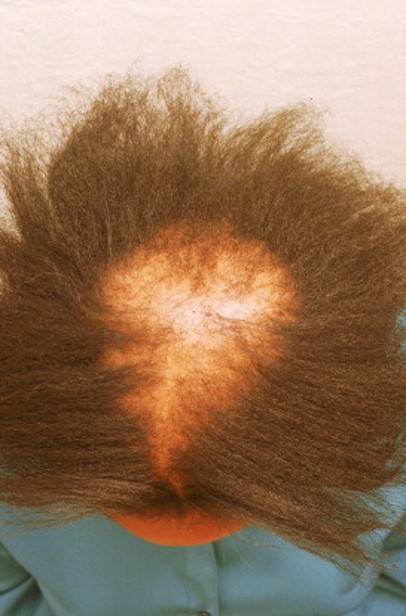STRIVING TO ALLEVIATE THE PHYSICAL AND EMOTIONAL SCARS OF CENTRAL CENTRIFUGAL CICATRICIAL ALOPECIA
STRIVING TO ALLEVIATE THE PHYSICAL AND EMOTIONAL SCARS OF CENTRAL CENTRIFUGAL CICATRICIAL ALOPECIA

By Warren R. Heymann, MD
November 4, 2020
Vol. 2, No. 44

CCCA commonly affects women of African descent, with the incidence in African-American women reportedly higher than in African women. CCCA is a progressive form of lymphocyte predominant scarring alopecia initially presenting on the crown or vertex scalp, subsequently spreading in a peripheral or centrifugal pattern. Along with the clinical observation of hair loss, there may be subclinical inflammation based on biopsy test results of a normal-appearing scalp. (2) Recently, a new clinical variant of CCCA presenting with patches of hair loss affecting the lateral and posterior scalp has been described. (3)
There may be systemic associations with CCCA. The Black Women's Health Study has collected data on medical and lifestyle factors, including diagnosis of type 2 diabetes. Over a 20-year period, 850 cases of severe hair loss occurred. The multivariable hazard ratio (HR) for severe hair loss associated with diabetes was 1.68 overall, and 2.05 for diabetes duration of ≥ 10 years. When the authors confined the case group to women reporting doctor-or biopsy-confirmed CCCA, the HR for diabetes was 2.24 compared to 1.68 in the larger case group, suggesting that the association might be greater than estimated. (4)

Dina et al, in a retrospective study of 487,104 black women >18 years of age, seen over a 4-year study period, identified a total of 447 women with a medical history of CCCA (0.09%), 62 of whom had uterine leiomyomas (Uls, fibroids). Approximately 13.9% of women with CCCA had a history of ULs (62 of 447) compared to 3.3% of women without CCCA (16,212 of 486,657), resulting in a highly significant odds ratio of 4.68. Interestingly, the authors note that people of African descent are at increased risk for fibroproliferative disorders such as sarcoidosis, uterine leiomyomas (ULs), and keloids. This risk is possibly due to the protective effect that profibrotic alleles have against endemic helminthic infections seen in sub-Saharan Africa. (5) Of course, this raises the question of genetic predisposition for patients with CCCA.
CCCA is occasionally observed to affect women in families in a manner suggesting an autosomal dominant trait. Using exome sequencing, Malki et al identified one splice site and three heterozygous missense mutations in PADI3 in 5 of 16 patients with CCCA (31%). The authors then directly sequenced PADI3 in an additional 42 patients and observed genetic variants in 9 of them. A post hoc analysis of the combined data sets showed that the prevalence of PADI3 mutation was significantly higher among patients with CCCA than in a control cohort of women of African ancestry. PADI3 encodes peptidyl arginine deiminase, type III (PADI3), an enzyme that post-translationally modifies other proteins that are essential to hair-shaft formation. PADI3 mediates deimination of hair structural proteins such as S100A3 in the cuticle, trichohyalin in the medulla, and the Henle layer of the inner root sheath. Previous observations have pointed to the importance of PADI3 for proper hair-shaft formation. (6)
Mutations of the PADI3 gene are also implicated in the uncombable hair syndrome (UHS). Basmanav et al reported the identification of UHS-causative mutations located in the 3 genes: PADI3 (peptidylarginine deiminase 3), TGM3 (transglutaminase 3), and TCHH (trichohyalin) in a total of 11 children. All of these individuals carry homozygous or compound heterozygous mutations in one of these three genes, indicating an autosomal recessive inheritance pattern in the majority of UHS case subjects. (7) As opposed to the UHS where biallelic mutations are noted, for CCCA patients, only one allele of PADI3 is affected. (6)
As intriguing as the genetics are in understanding the pathogenesis of CCCA, the PADI3 mutation only involves approximately one-third of affected patients. Other factors must be at play. Anzai et al observe: "The hair follicle (HF) is a complex mini-organ that constantly undergoes dynamic cycles of growth and regression throughout life. While proper progression of the hair cycle requires homeostatic interplay between the HF and its immune microenvironment, specific parts of the HF, such as the bulge throughout the hair cycle and the bulb in the anagen phase, maintain relative immune privilege (IP). When this IP collapses, inflammatory infiltrates that aggregate around the bulge and bulb launch an immune attack on the HF, resulting in hair loss or alopecia." (8) Perhaps certain triggers, including cosmetic hair care practices, disrupt the IP site in CCCA-susceptible patients. More research is warranted.
Treatment of CCCA depends upon the stage of disease. In the active phase, high-potency topical corticosteroids, intralesional corticosteroids, calcineurin inhibitors, oral doxycycline or minocycline, or hydroxychloroquine may be utilized. Once stabilized, maintenance is achieved with mid-potency topical corticosteroid agents and/or calcineurin inhibitors. Disease must be quiescent on medical therapy for 9 to 12 months, and confirmed with a test biopsy, before hair transplantation can be considered. (2)
CCCA may be psychologically devastating. I have had innumerable patients who have been profoundly discouraged, if not depressed, by the disease. While current therapies offer a modicum of benefit, the path forward is to further scrutinize the pathogenic mechanisms of CCCA so that personalized, targeted preventive therapy can obviate progression to scarring alopecia.
Point to Remember: In some patients, CCCA may have a genetic predisposition due to mutations the PADI3 (peptidylarginine deiminase 3) gene. This discovery offers a window in comprehending the pathogenesis of CCCA, hopefully allowing for the development of individualized targeted therapies for a troublesome disorder.
Our Experts' Viewpoints
George Cotsarelis, MD
Milton Bixler Hartzell Professor of Dermatology
Perelman School of Medicine, University of Pennsylvania
Cicatricial or scarring alopecias result from loss of hair follicles and their replacement with a scar. One can imagine "defects" in multiple different cell types leading to loss of hair follicles and scar formation. In CCCA, the latest data indicate that mutations in PADI3 may account for many cases of this disorder. PADI3 codes for an enzyme in the hair shaft that is responsible for modifying proteins so that they can interact and form a strong hair shaft. The hair shaft has a rich assortment of proteins that have to engage with each other to achieve the production of a strong hair fiber. Defects in hair shaft proteins result in aberrant hair shafts, which often are fragile. This suggests that increased fragility of hair is associated with CCCA.
Given that the hair follicle producing tightly curled African hair has a characteristic curved sickle shape, traumatizing already fragile hair through traction or chemicals would be more likely to cause hair shaft breakage within the follicle leading to inflammation, loss of stem cells, and eventual loss of the follicle. A predisposition toward fibrosis because of overactive fibroblast or immune cells would make the situation worse and also predispose to other conditions, such as leiomyomas that have been described as more common in CCCA patients.
This concept that aberrant hair shafts are associated with CCCA would explain why CCCA is so common. Because hair shaft integrity requires the orderly arrangement of hundreds of proteins, defects in almost any of these likely could lead to a susceptibility to developing CCCA. Undoubtedly, the future will bring wonderful new insights into understanding the pathogenesis of this difficult-to-treat disorder.
Dr. Cotsarelis had disclosed financial relationships with the following to the AAD at the time of publication: Allergan, Inc, Cassiopea S.p.A., Eli Lilly and Company, Follica, JW Pharmaceutical Corp, LEO Pharma. Full disclosure information is available at coi.aad.org.
LoPresti P, Papa CM, Kligman AM. Hot comb alopecia. Arch Dermatol 1968; 98: 234-238.
Okereke UR, Simmons A, Callender VD. Current and emergent treatment strategies for hair loss in women of color. Int J Women's Dermatol 2019; 5: 37-45.
Gomez-Zubiaur A, Saceda-Corralo D, Velez-Velázquez MD, Rodriguez-Villa Lario A, Trasobares-Marugan L. Central centrifugal cicatricial alopecia following a patchy pattern: A new form of clinical presentation and a challenging diagnosis for the dermatologist. Int J Trichilology 2019; 11: 216-218.
Coogan PF, Bethea TN, Cozier YC, Bertrand KA, et al. Association of type 2 diabetes with central-scalp hair loss in a large cohort study of African American women. Int J Women's Dermatol 2019; 3: 261-266.
Dina Y, Okoye GA, Aguh C. Association of uterine leiomyomas with central centrifugal cicatricial alopecia. JAMA Dermatol 2018; 154: 213-214.
Malki L, Sarig O, Romano MT, Méchin MC, et al. Variant PADI3 in central centrifugal cicatricial alopecia. N Engl J Med 2019: 380: 833-841.
Basmanav FBÜ, Cau L, Tafazzoli A, Méchin MC, et al. Mutations in three genes encoding proteins involved in hair shaft formation cause uncombable hair syndrome. Am J Hum Genet 2016; 99: 1292-1304.
Anzai A, Wang EHC, Lee EY, Aoki V, Christiano AM. Pathomechanisms of immune-mediated alopecia. Int Immunol 2019; 31: 439-447.
All content found on Dermatology World Insights and Inquiries, including: text, images, video, audio, or other formats, were created for informational purposes only. The content represents the opinions of the authors and should not be interpreted as the official AAD position on any topic addressed. It is not intended to be a substitute for professional medical advice, diagnosis, or treatment.
DW Insights and Inquiries archive
Explore hundreds of Dermatology World Insights and Inquiries articles by clinical area, specific condition, or medical journal source.
Skin Care Physicians of Costa Rica
Clinica Victoria en San Pedro: 4000-1054
Momentum Escazu: 2101-9574
Please excuse the shortness of this message, as it has been sent from
a mobile device.
posted by dermatica at
November 04, 2020
![]()
![]()

0 Comments:
Post a Comment
Subscribe to Post Comments [Atom]
<< Home